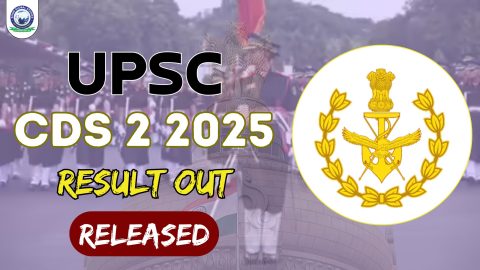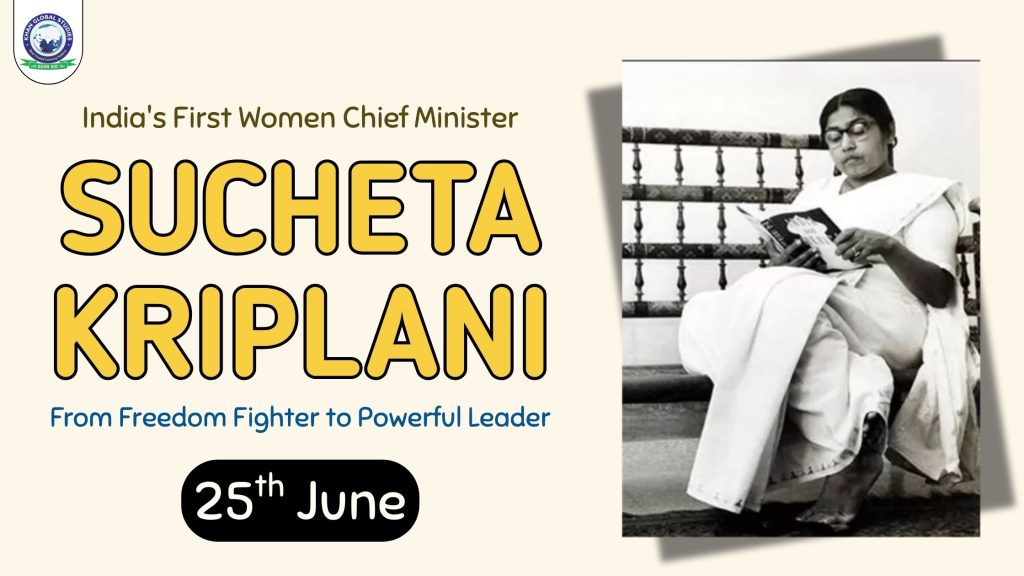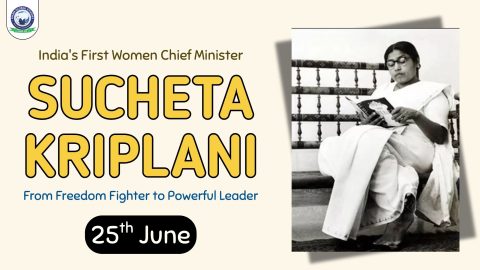Sucheta Kripalani was a pioneering freedom fighter, stateswoman, and reformer, widely celebrated as India’s first woman Chief Minister. Her political journey and commitment to national service are hallmarks of a visionary leader who not only contributed to India’s struggle for independence but also shaped its early democratic framework. Born on June 25, 1908, Sucheta Kripalani left an indelible mark on Indian history, becoming an enduring symbol of women’s empowerment and political leadership in the country.
Who Was Sucheta Kripalani, India’s First Woman Chief Minister?
June 25 marks the birth anniversary of Sucheta Kripalani, a remarkable leader and India’s first woman Chief Minister. Born in 1908, she played a key role in the country’s freedom struggle and later served as the Chief Minister of Uttar Pradesh from October 2, 1963, to March 13, 1967. After her term as Chief Minister, she continued to serve as a Member of Parliament in the Lok Sabha until 1971.
How Sucheta Kripalani Made History?
In late September 1963, the Congress party was looking for a new Chief Minister for Uttar Pradesh after Chandra Bhanu Gupta was asked to step down. During this time, Gupta visited Acharya J B Kripalani, a respected Congress leader and Gandhian, in Delhi. Sucheta Kripalani, his wife and a cabinet colleague of Gupta, was also there, caring for her husband. J B Kripalani jokingly suggested to Gupta, “Why don’t you make Sucheta the Chief Minister?” This light-hearted comment turned out to be prophetic, as Sucheta Kripalani was soon chosen for the role, making history as the first woman to lead an Indian state.
Remembering Sucheta Kripalani
On June 25, 2024, India celebrated the birth anniversary of Sucheta Kripalani—a chance to honour her dedication to the country’s independence and her groundbreaking work in politics.
Early Life and Education of Sucheta Kripalani
Sucheta Kripalani was born in Ambala, then a part of Punjab in British India, into a Bengali family with a strong educational background. Her father, S.N. Majumdar, served as a government doctor. From an early age, Sucheta displayed a keen interest in academics and public affairs. She pursued her higher education at Indraprastha College, followed by a degree in History from the University of Delhi.
Her educational journey laid a strong intellectual foundation, helping her evolve into a powerful orator and an analytical thinker. It was during her early teaching career at Banaras Hindu University that she began developing a deeper awareness of India’s colonial struggle and was drawn into the freedom movement.
Role in India’s Freedom Struggle
Sucheta entered politics during a time of great change in India. She married Acharya Kripalani, a prominent freedom fighter, in 1936. Two years later, she joined the Congress Party and soon became Secretary of the Foreign Department and Women’s Section.
Mahatma Gandhi deeply influenced her and took part in the Quit India Movement in 1942. In 1946, she was elected to the Constituent Assembly from the United Provinces and helped present the first Indian flag to the Assembly.
Role in the Constituent Assembly
Sucheta Kripalani was elected to the Constituent Assembly in 1946, representing the United Provinces (now Uttar Pradesh). She was among the select few women who participated in the monumental task of drafting the Indian Constitution. Her commitment to democratic values, civil liberties, and women’s rights was evident in the debates and discussions within the Assembly.
She was also part of the historic event when the first Indian flag was presented to the Constituent Assembly—a moment symbolic of the dawn of a new era. Sucheta’s active involvement in shaping post-independence India earned her the respect of colleagues across party lines.
Political Career After Independence
Post-1947, Sucheta Kripalani continued to serve in various legislative roles. She was elected to:
- The Provisional Parliament (1950–1952)
- The First Lok Sabha (1952–1957)
- The Second Lok Sabha (1957–1962)
In Parliament, her eloquence, administrative acumen, and moral integrity stood out. She was vocal on issues of women’s empowerment, education, and rural development. Her stature grew within the Congress Party, and she emerged as one of the most respected leaders of her generation.
Major Achievements as Chief Minister
During her tenure, Sucheta Kripalani prioritized good governance, ethical politics, and socioeconomic reforms. Some of her notable achievements include:
- Reform of state administration and crackdown on corruption
- Strengthening education policies, especially for rural and underprivileged communities
- Enhancing healthcare access and public infrastructure development
- Advocating for women’s welfare and social justice
- Handling a major strike by state government employees in 1967 with firmness and diplomacy, ensuring that governance was not paralyzed
Her tenure was marked by transparency, accountability, and a people-first approach, setting a new standard for political leadership.
International Representation and Contributions
Sucheta Kripalani also made her mark in the global arena, representing India in several international forums:
- United Nations General Assembly (1949)
- Parliamentary Delegation to Turkey (1954)
- International Labour Organization (ILO) Meeting (1961)
These participations reflected her global vision and understanding of international diplomacy and labour rights.
Legacy
Sucheta Kripalani’s influence goes far beyond her political roles. She opened doors for women in Indian politics and inspired many to take up public service. Her commitment to justice, honesty, and the nation’s progress continues to motivate people across India.
Conclusion
Sucheta Kripalani’s journey from a freedom fighter to India’s first woman Chief Minister is not just a chapter in history—it is a guiding light for future generations. Her contributions to India’s independence, her leadership in governance, and her commitment to public welfare are worthy of celebration and remembrance.





